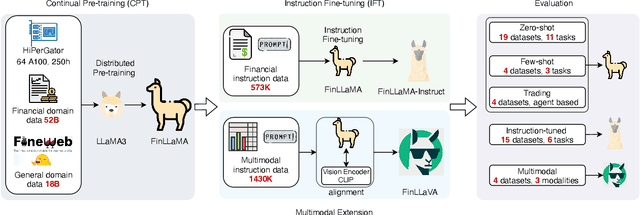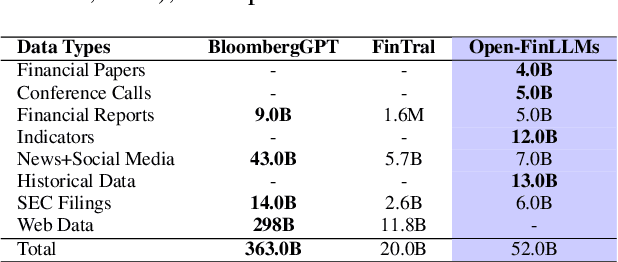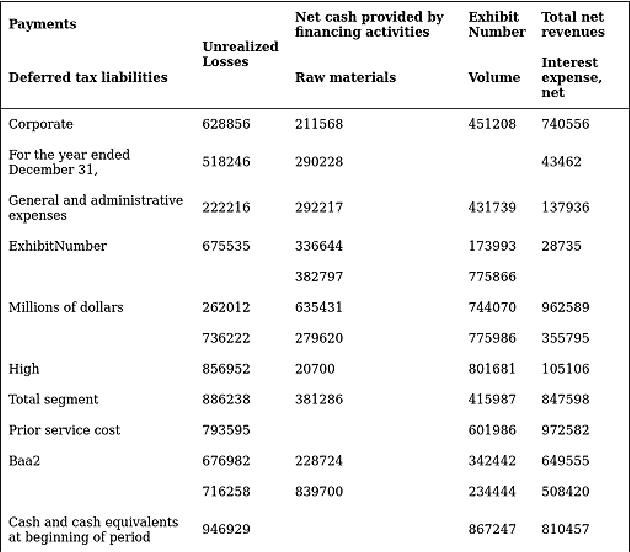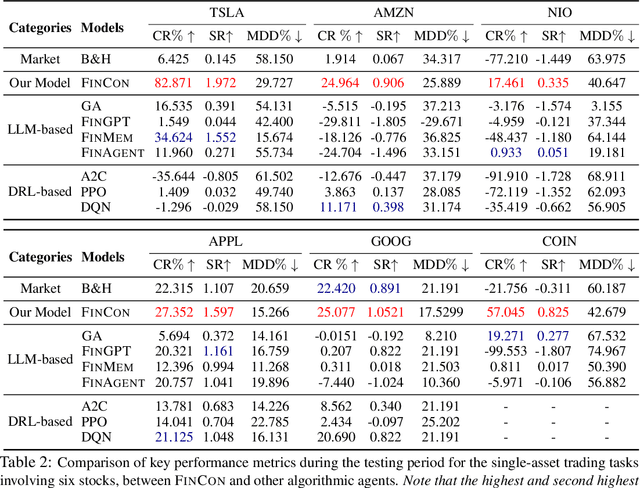Yupeng Cao
Can AI Validate Science? Benchmarking LLMs for Accurate Scientific Claim $\rightarrow$ Evidence Reasoning
Jun 09, 2025Abstract:Large language models (LLMs) are increasingly being used for complex research tasks such as literature review, idea generation, and scientific paper analysis, yet their ability to truly understand and process the intricate relationships within complex research papers, such as the logical links between claims and supporting evidence remains largely unexplored. In this study, we present CLAIM-BENCH, a comprehensive benchmark for evaluating LLMs' capabilities in scientific claim-evidence extraction and validation, a task that reflects deeper comprehension of scientific argumentation. We systematically compare three approaches which are inspired by divide and conquer approaches, across six diverse LLMs, highlighting model-specific strengths and weaknesses in scientific comprehension. Through evaluation involving over 300 claim-evidence pairs across multiple research domains, we reveal significant limitations in LLMs' ability to process complex scientific content. Our results demonstrate that closed-source models like GPT-4 and Claude consistently outperform open-source counterparts in precision and recall across claim-evidence identification tasks. Furthermore, strategically designed three-pass and one-by-one prompting approaches significantly improve LLMs' abilities to accurately link dispersed evidence with claims, although this comes at increased computational cost. CLAIM-BENCH sets a new standard for evaluating scientific comprehension in LLMs, offering both a diagnostic tool and a path forward for building systems capable of deeper, more reliable reasoning across full-length papers.
Truth Neurons
May 18, 2025Abstract:Despite their remarkable success and deployment across diverse workflows, language models sometimes produce untruthful responses. Our limited understanding of how truthfulness is mechanistically encoded within these models jeopardizes their reliability and safety. In this paper, we propose a method for identifying representations of truthfulness at the neuron level. We show that language models contain truth neurons, which encode truthfulness in a subject-agnostic manner. Experiments conducted across models of varying scales validate the existence of truth neurons, confirming that the encoding of truthfulness at the neuron level is a property shared by many language models. The distribution patterns of truth neurons over layers align with prior findings on the geometry of truthfulness. Selectively suppressing the activations of truth neurons found through the TruthfulQA dataset degrades performance both on TruthfulQA and on other benchmarks, showing that the truthfulness mechanisms are not tied to a specific dataset. Our results offer novel insights into the mechanisms underlying truthfulness in language models and highlight potential directions toward improving their trustworthiness and reliability.
FinAudio: A Benchmark for Audio Large Language Models in Financial Applications
Mar 26, 2025Abstract:Audio Large Language Models (AudioLLMs) have received widespread attention and have significantly improved performance on audio tasks such as conversation, audio understanding, and automatic speech recognition (ASR). Despite these advancements, there is an absence of a benchmark for assessing AudioLLMs in financial scenarios, where audio data, such as earnings conference calls and CEO speeches, are crucial resources for financial analysis and investment decisions. In this paper, we introduce \textsc{FinAudio}, the first benchmark designed to evaluate the capacity of AudioLLMs in the financial domain. We first define three tasks based on the unique characteristics of the financial domain: 1) ASR for short financial audio, 2) ASR for long financial audio, and 3) summarization of long financial audio. Then, we curate two short and two long audio datasets, respectively, and develop a novel dataset for financial audio summarization, comprising the \textsc{FinAudio} benchmark. Then, we evaluate seven prevalent AudioLLMs on \textsc{FinAudio}. Our evaluation reveals the limitations of existing AudioLLMs in the financial domain and offers insights for improving AudioLLMs. All datasets and codes will be released.
FLAG-Trader: Fusion LLM-Agent with Gradient-based Reinforcement Learning for Financial Trading
Feb 19, 2025Abstract:Large language models (LLMs) fine-tuned on multimodal financial data have demonstrated impressive reasoning capabilities in various financial tasks. However, they often struggle with multi-step, goal-oriented scenarios in interactive financial markets, such as trading, where complex agentic approaches are required to improve decision-making. To address this, we propose \textsc{FLAG-Trader}, a unified architecture integrating linguistic processing (via LLMs) with gradient-driven reinforcement learning (RL) policy optimization, in which a partially fine-tuned LLM acts as the policy network, leveraging pre-trained knowledge while adapting to the financial domain through parameter-efficient fine-tuning. Through policy gradient optimization driven by trading rewards, our framework not only enhances LLM performance in trading but also improves results on other financial-domain tasks. We present extensive empirical evidence to validate these enhancements.
INVESTORBENCH: A Benchmark for Financial Decision-Making Tasks with LLM-based Agent
Dec 24, 2024



Abstract:Recent advancements have underscored the potential of large language model (LLM)-based agents in financial decision-making. Despite this progress, the field currently encounters two main challenges: (1) the lack of a comprehensive LLM agent framework adaptable to a variety of financial tasks, and (2) the absence of standardized benchmarks and consistent datasets for assessing agent performance. To tackle these issues, we introduce \textsc{InvestorBench}, the first benchmark specifically designed for evaluating LLM-based agents in diverse financial decision-making contexts. InvestorBench enhances the versatility of LLM-enabled agents by providing a comprehensive suite of tasks applicable to different financial products, including single equities like stocks, cryptocurrencies and exchange-traded funds (ETFs). Additionally, we assess the reasoning and decision-making capabilities of our agent framework using thirteen different LLMs as backbone models, across various market environments and tasks. Furthermore, we have curated a diverse collection of open-source, multi-modal datasets and developed a comprehensive suite of environments for financial decision-making. This establishes a highly accessible platform for evaluating financial agents' performance across various scenarios.
Open-FinLLMs: Open Multimodal Large Language Models for Financial Applications
Aug 20, 2024



Abstract:Large language models (LLMs) have advanced financial applications, yet they often lack sufficient financial knowledge and struggle with tasks involving multi-modal inputs like tables and time series data. To address these limitations, we introduce \textit{Open-FinLLMs}, a series of Financial LLMs. We begin with FinLLaMA, pre-trained on a 52 billion token financial corpus, incorporating text, tables, and time-series data to embed comprehensive financial knowledge. FinLLaMA is then instruction fine-tuned with 573K financial instructions, resulting in FinLLaMA-instruct, which enhances task performance. Finally, we present FinLLaVA, a multimodal LLM trained with 1.43M image-text instructions to handle complex financial data types. Extensive evaluations demonstrate FinLLaMA's superior performance over LLaMA3-8B, LLaMA3.1-8B, and BloombergGPT in both zero-shot and few-shot settings across 19 and 4 datasets, respectively. FinLLaMA-instruct outperforms GPT-4 and other Financial LLMs on 15 datasets. FinLLaVA excels in understanding tables and charts across 4 multimodal tasks. Additionally, FinLLaMA achieves impressive Sharpe Ratios in trading simulations, highlighting its robust financial application capabilities. We will continually maintain and improve our models and benchmarks to support ongoing innovation in academia and industry.
FinCon: A Synthesized LLM Multi-Agent System with Conceptual Verbal Reinforcement for Enhanced Financial Decision Making
Jul 10, 2024



Abstract:Large language models (LLMs) have demonstrated notable potential in conducting complex tasks and are increasingly utilized in various financial applications. However, high-quality sequential financial investment decision-making remains challenging. These tasks require multiple interactions with a volatile environment for every decision, demanding sufficient intelligence to maximize returns and manage risks. Although LLMs have been used to develop agent systems that surpass human teams and yield impressive investment returns, opportunities to enhance multi-sourced information synthesis and optimize decision-making outcomes through timely experience refinement remain unexplored. Here, we introduce the FinCon, an LLM-based multi-agent framework with CONceptual verbal reinforcement tailored for diverse FINancial tasks. Inspired by effective real-world investment firm organizational structures, FinCon utilizes a manager-analyst communication hierarchy. This structure allows for synchronized cross-functional agent collaboration towards unified goals through natural language interactions and equips each agent with greater memory capacity than humans. Additionally, a risk-control component in FinCon enhances decision quality by episodically initiating a self-critiquing mechanism to update systematic investment beliefs. The conceptualized beliefs serve as verbal reinforcement for the future agent's behavior and can be selectively propagated to the appropriate node that requires knowledge updates. This feature significantly improves performance while reducing unnecessary peer-to-peer communication costs. Moreover, FinCon demonstrates strong generalization capabilities in various financial tasks, including single stock trading and portfolio management.
CatMemo at the FinLLM Challenge Task: Fine-Tuning Large Language Models using Data Fusion in Financial Applications
Jul 02, 2024Abstract:The integration of Large Language Models (LLMs) into financial analysis has garnered significant attention in the NLP community. This paper presents our solution to IJCAI-2024 FinLLM challenge, investigating the capabilities of LLMs within three critical areas of financial tasks: financial classification, financial text summarization, and single stock trading. We adopted Llama3-8B and Mistral-7B as base models, fine-tuning them through Parameter Efficient Fine-Tuning (PEFT) and Low-Rank Adaptation (LoRA) approaches. To enhance model performance, we combine datasets from task 1 and task 2 for data fusion. Our approach aims to tackle these diverse tasks in a comprehensive and integrated manner, showcasing LLMs' capacity to address diverse and complex financial tasks with improved accuracy and decision-making capabilities.
RITA: A Real-time Interactive Talking Avatars Framework
Jun 18, 2024Abstract:RITA presents a high-quality real-time interactive framework built upon generative models, designed with practical applications in mind. Our framework enables the transformation of user-uploaded photos into digital avatars that can engage in real-time dialogue interactions. By leveraging the latest advancements in generative modeling, we have developed a versatile platform that not only enhances the user experience through dynamic conversational avatars but also opens new avenues for applications in virtual reality, online education, and interactive gaming. This work showcases the potential of integrating computer vision and natural language processing technologies to create immersive and interactive digital personas, pushing the boundaries of how we interact with digital content.
ECC Analyzer: Extract Trading Signal from Earnings Conference Calls using Large Language Model for Stock Performance Prediction
Apr 29, 2024Abstract:In the realm of financial analytics, leveraging unstructured data, such as earnings conference calls (ECCs), to forecast stock performance is a critical challenge that has attracted both academics and investors. While previous studies have used deep learning-based models to obtain a general view of ECCs, they often fail to capture detailed, complex information. Our study introduces a novel framework: \textbf{ECC Analyzer}, combining Large Language Models (LLMs) and multi-modal techniques to extract richer, more predictive insights. The model begins by summarizing the transcript's structure and analyzing the speakers' mode and confidence level by detecting variations in tone and pitch for audio. This analysis helps investors form an overview perception of the ECCs. Moreover, this model uses the Retrieval-Augmented Generation (RAG) based methods to meticulously extract the focuses that have a significant impact on stock performance from an expert's perspective, providing a more targeted analysis. The model goes a step further by enriching these extracted focuses with additional layers of analysis, such as sentiment and audio segment features. By integrating these insights, the ECC Analyzer performs multi-task predictions of stock performance, including volatility, value-at-risk (VaR), and return for different intervals. The results show that our model outperforms traditional analytic benchmarks, confirming the effectiveness of using advanced LLM techniques in financial analytics.
 Add to Chrome
Add to Chrome Add to Firefox
Add to Firefox Add to Edge
Add to Edge